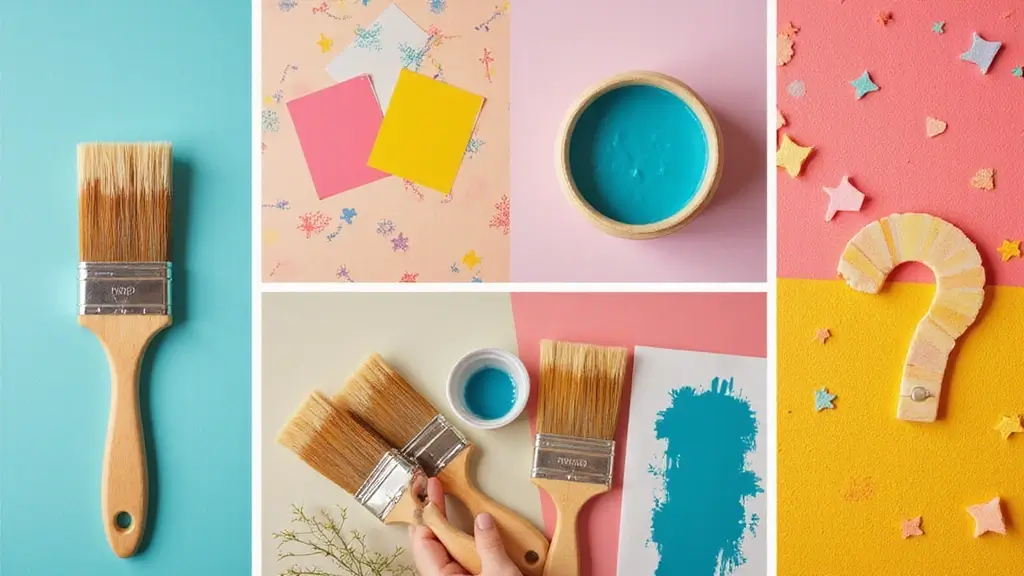This season has me craving easy, playful paint ideas for kids’ bedrooms. I created this post to give you real, doable ways to brighten a wall without turning your home upside down. Blank walls can feel dull fast, and color can spark a kid’s imagination the moment they walk in. I focused on options that are simple, budget-friendly, and safe for little painters.
If you care about a space that is cozy, easy to clean, and not loud, this one is for you. Parents, guardians, and anyone who shares a room with a child will find ideas that fit real life. This guide is for busy families who want a fresh look without a big project.
I pulled together twenty-five ideas that cover everything from soft color blocks to small murals. They come with simple how-tos, quick tips on tape, brushes, and finishes, and a plan you can actually finish in a weekend. I’ll show you ways to test color in the room and pick shades that grow with your kid. These ideas also hint at different moods, from calm corners to playful accents.
These ideas work in small rooms, shared spaces, or any wall that begs for a little personality. Choose colors that pair with existing furniture, floors, and lighting. Many ideas can be swapped in later without a redo. You can use low-odor paints and easy cleanup tricks to keep things simple.
With these ideas you can plan a mood board, pick a base color, and add two accents. Think about texture with matte or satin finishes and a few DIY touches like stenciled stars or color-block borders. The projects are friendly for beginners and still look polished when guests walk by.
Next, scroll through the ideas and pick one or two to try this weekend. Or save the post for later and map out a tiny project for next month. Either way, you’ll finish with walls that feel playful, calm, or bold, whichever fits your kid’s vibe.
1. Rainbow Dreams
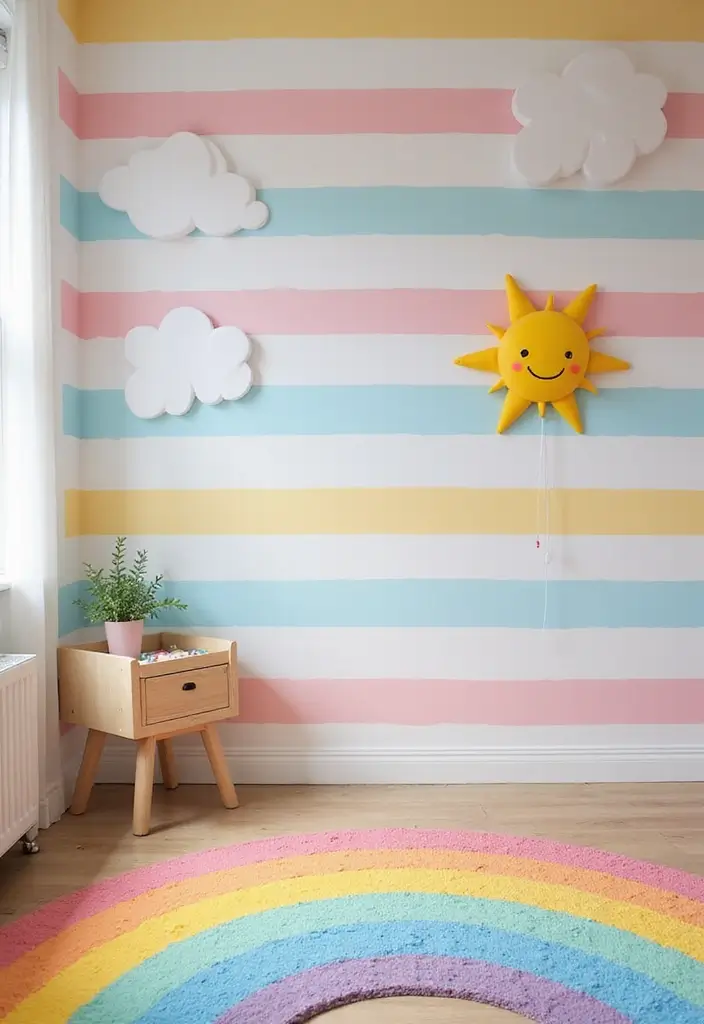
Want a kid’s room that feels cheerful without loud tones? Rainbow Dreams uses soft pastel stripes to paint a friendly rainbow on the wall. The arc stays playful and calm, inviting imagination.
Here is why this approach works. Light colors make a space feel bigger. Clean lines from tape keep the look neat. A rainbow mural gives daily inspiration for play, drawing, and story time.
How to build the look:
– Plan the stripes first. Decide how many bands you want and how wide they should be.
– Mark guiding lines with a pencil, then apply painter’s tape along each edge.
– Pick a gentle palette. Start with pale lavender or baby blue at the top, then add brighter shades like sunny yellow and grassy green as you go down. Finish with a soft pink or peach if you like.
– Paint in layers. Do one color at a time inside the taped areas. Let it dry before you add the next shade.
– Remove the tape carefully after the final coat for crisp edges.
Finish with cute details:
– Cloud decals above the rainbow add a dreamy touch.
– A small rainbow wall art piece or a chalkboard paint stripe gives kids a place to draw.
Care and supplies:
– Use low-VOC paints for healthier air.
– Protect floors with a drop cloth.
– Keep a damp cloth handy for quick tidying.
Pro Tips:
– Use painter’s tape for clean stripes.
– Choose colors that match the room decor.
– Consider a chalkboard paint accent for a drawing space.
This rainbow theme brightens the room and invites your child to dream and create.
2. Nature’s Palette
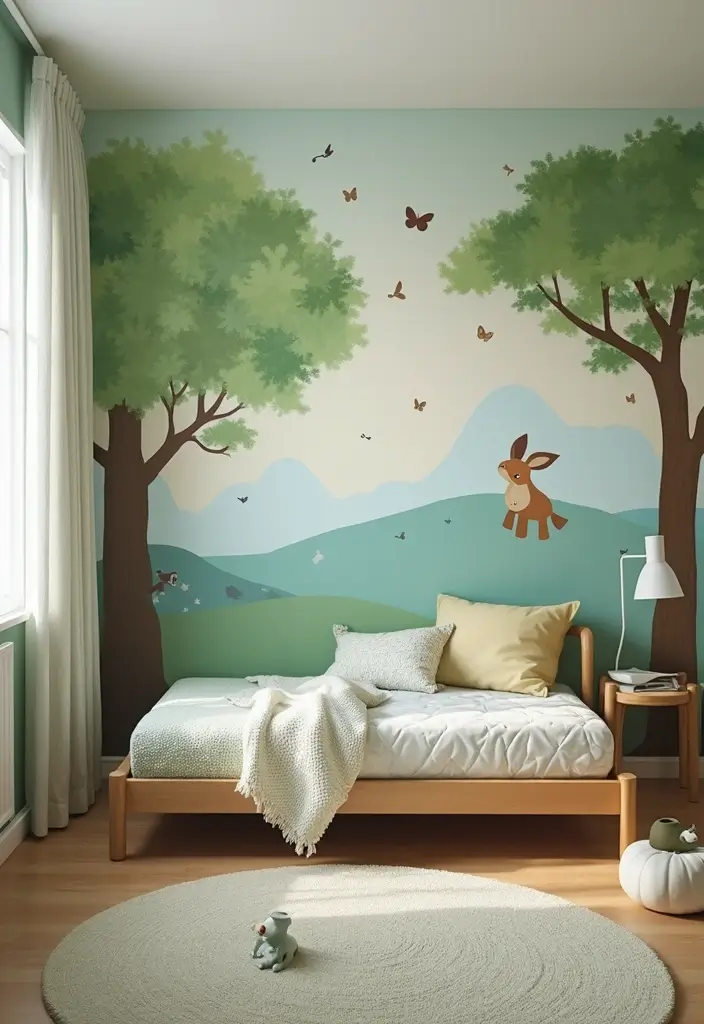
You want a kid’s room that feels calm and alive at the same time. A nature-inspired wall color can do that in a single sweep. Use soft greens, earthy browns, and sky blues to echo the outdoors and steady the mind.
Try a floor-to-ceiling gradient. Start with a deeper green or brown at the floor and blend up to a lighter blue near the ceiling. This simple sweep adds depth and a peaceful mood you can feel as you walk in.
Next, add trees or animal shapes along the lower wall or as a full mural. Use stencils, taped outlines, or removable decals to keep changes easy. Keep the designs gentle in size so the room does not feel crowded.
Pro Tips:
– Choose non-toxic, kid-safe paints.
– Pair the walls with natural wood furniture for a grounded look.
– Include a few real or artificial plants to bring in texture and life.
A nature-inspired palette connects kids to the world outside and provides a soothing stage for play, learning, and dreams. You can swap accents later without repainting the whole space. Start with the basics, test colors in daylight, and keep finishes matte to reduce glare. This approach stays fresh as your child grows.
3. Bold Geometric Shapes
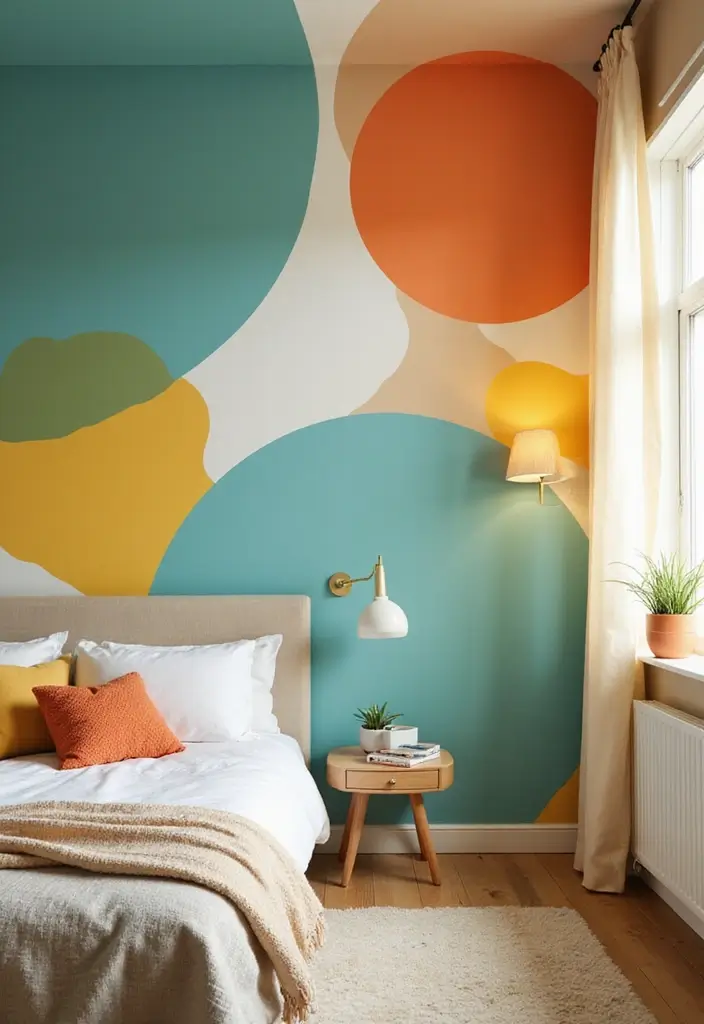
If you want a kid’s room that feels alive, bold geometric shapes can spark creativity. Start with one or two walls and a bright color mix. Teal, orange, and yellow pair well with large triangles, circles, and squares. The shapes create contrast and give the space a playful edge.
Here is how to do it. Plan first by sketching placements on paper. Then tape the wall and press the edges firm. Paint the shapes in two coats for solid color. Remove the tape while the paint is still a touch damp to keep edges clean.
Finish with texture and cohesion. Mix matte and gloss finishes to add depth. Use a simple backdrop to make colors pop, and choose bedding or a rug with geometric patterns to tie the look together. Make sure the design fits the room layout so it feels connected.
Pro Tips:
– Keep a monochrome version if you want a calmer vibe.
– Add texture with a mix of matte and gloss finishes.
– Check that shapes align with doors, windows, and furniture.
This approach invites your child to think creatively and to enjoy a space that looks designed.
4. Enchanted Forest
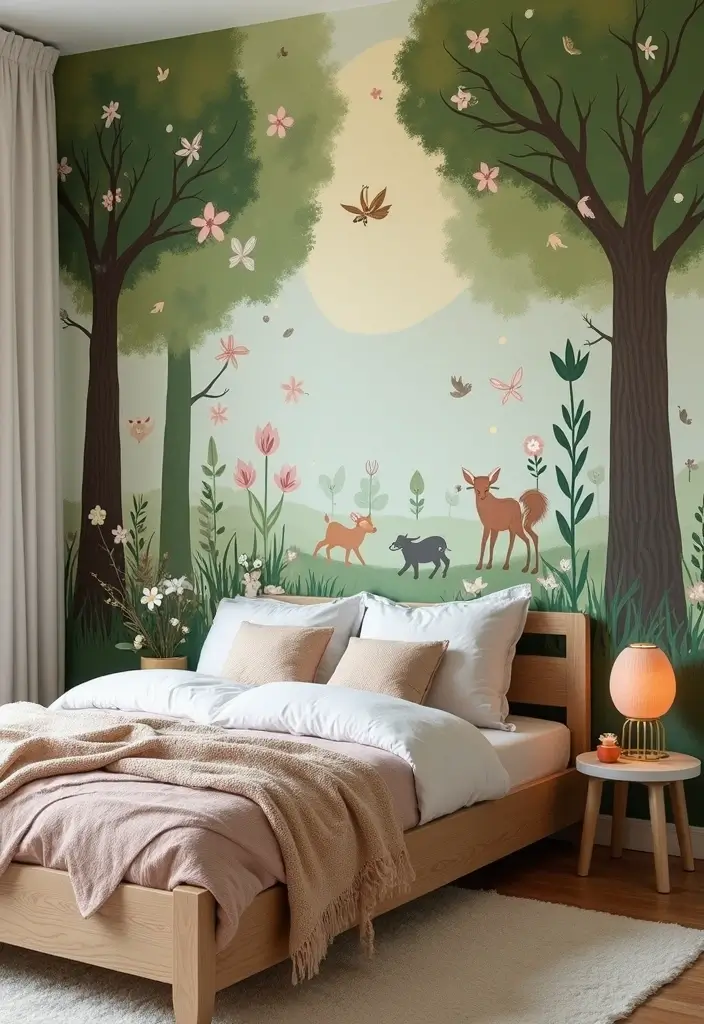
You want a child’s room that feels like a magic place. A forest theme can do that. It sparks imagination and gives a calm, cozy retreat.
Start with earthy greens, browns, and soft creams. Paint a mural on one wall that stretches from floor to ceiling. Show tall trees, curious animals, and gentle flowers. Use non toxic paints so the air stays clean. For tidy results, lay out the design in layers: a light base, then darker trunks, then soft details. Keep the color story simple so it is easy for your child to read. Let the scene invite a story at bedtime or during play.
Here is why this works. It brings nature inside and helps the room feel safe. It gives a soft color story kids can explore in their games. It also creates a great backdrop for books, toys, and easels.
Pro Tips:
– Use stencils to draw repeatable trees and animals.
– Add nature-themed decor like leaf rugs or wooden toys.
– String soft fairy lights for a gentle, magical glow.
An enchanted forest design fuels imagination and gives a calm corner for reading and rest. With careful planning, it stays fresh for years and grows with your child.
5. Space Adventure
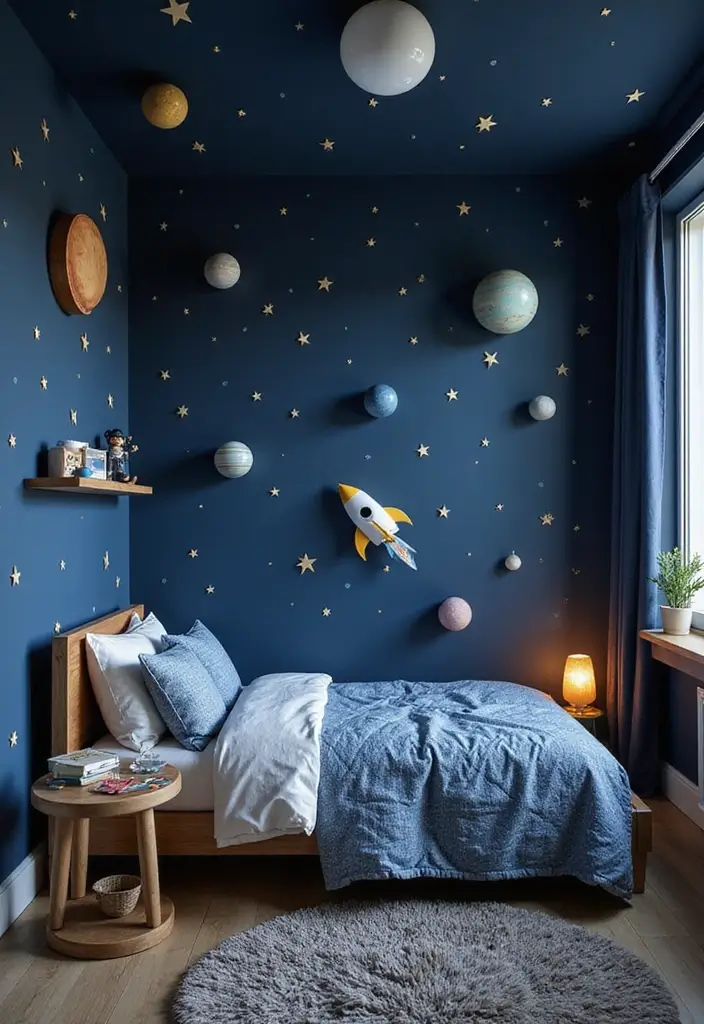
If your child loves space, this theme can turn a bedroom into a launch pad for imagination. Start with a deep base color. Navy blue or midnight black walls feel like a real night sky.
Next, paint a large mural. A wall that shows a night sky, bright planets, and friendly rocket ships makes the room feel alive. Add a few distant stars for depth and movement. Glow-in-the-dark dots bring the scene to life when lights go out.
This look works because it invites questions. It turns science into daily fun and play into learning. A space theme also stays fresh as your child grows.
Here is why this approach shines:
– It creates a calm, focused backdrop for bedtime stories and quiet science moments.
– It gives you a clear palette to guide decor, bedding, and accessories.
– It blends education with play, so you can add hands-on tools later without redoing the room.
Pro Tips:
– Use glow-in-the-dark paint for stars and planets to keep a night-time sky visible after dark.
– Pick space bedding and decor that echo the mural for a cohesive look.
– Consider a telescope or star map as a practical, fun add-on.
Next steps: choose a wall, pick a mural plan, and map where furniture will sit. A space adventure room grows with your child and fuels curiosity.
6. Playful Pastels
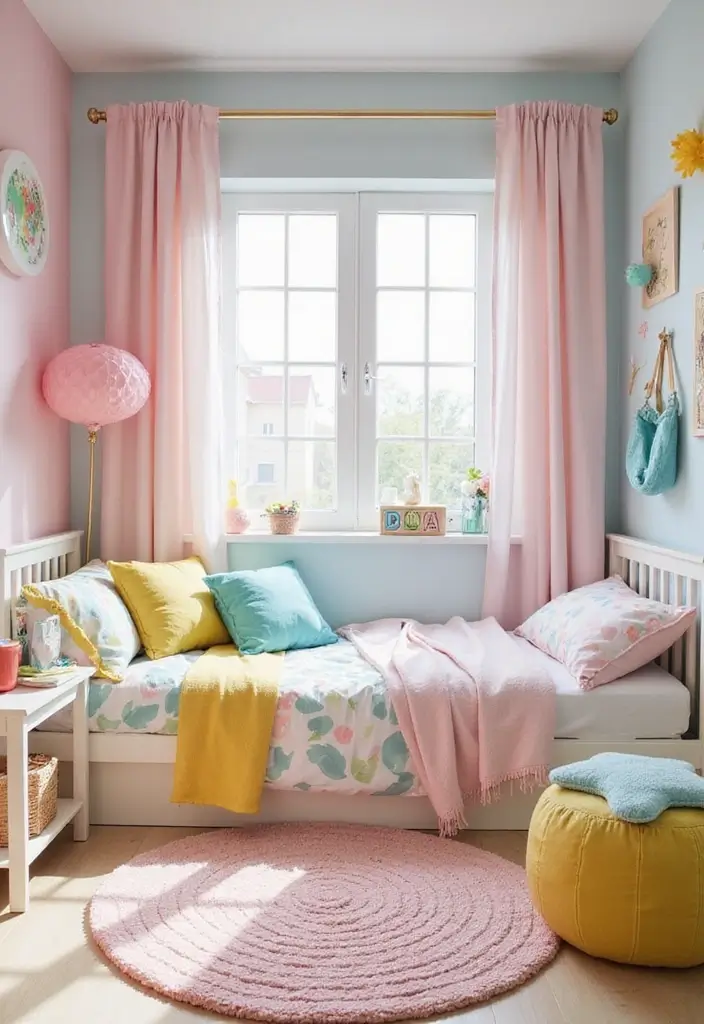
Want a kid’s room that feels bright but not busy? Playful pastels do the job. Try a palette of light pinks, baby blues, soft yellows, and mint greens. Use them on the walls for a clean backdrop, or mix in patterns like polka dots or narrow stripes. Pastel tones soften the light and help colors pop without shouting.
Here is how to use them well. You can paint all walls one shade for a calm base. Or split the walls with two shades and add a simple tape pattern. Add wall decals in pastel shapes to repeat the color theme. The result is inviting and easy to live with.
Pro Tips:
– Mix several pastel colors for a lively, friendly vibe.
– Choose wall-mounted shelves in pastel tones to hold books, toys, and art.
– Put a pastel rug under the bed or reading chair to tie the room together.
To go further, pair pastel furniture with white or light wood pieces. A pale pink desk, a mint chair, or a cream bed frame works well. Add a small chalkboard wall for doodles and notes. Finish with soft textures, like a knit throw, so the space stays cozy. If your room gets a lot of sun, pastel colors glow even more.
7. Under the Sea
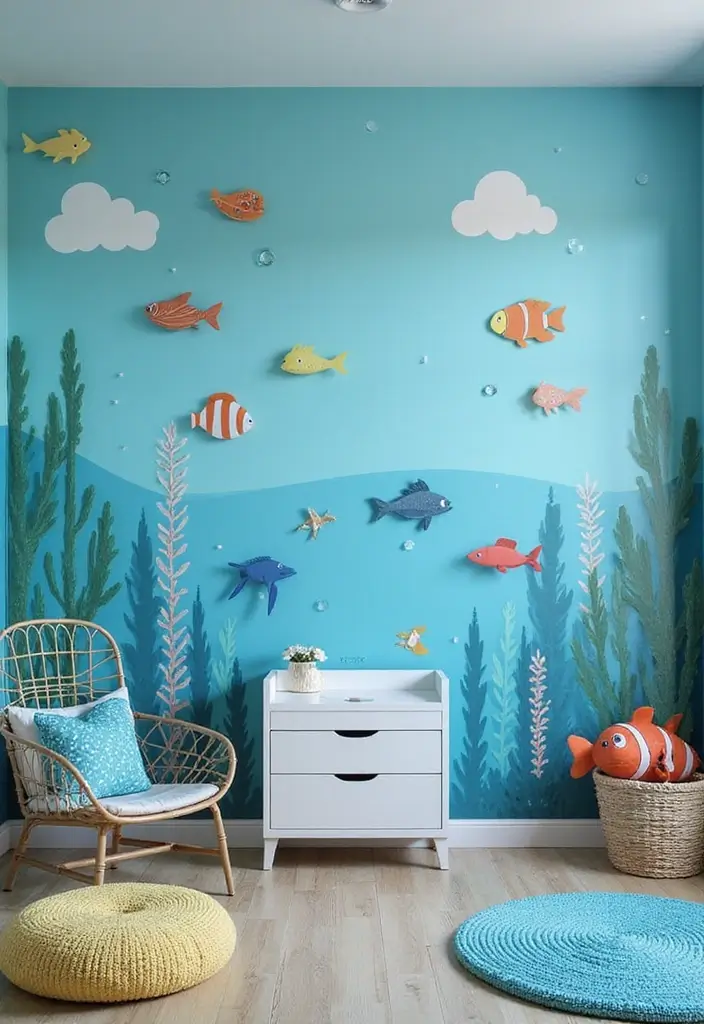
You want a kid’s room that feels calm and invites daily discoveries. A sea themed paint job can do that.
Start with a simple color plan. Pick blues and turquoise. Use a light sky blue on the ceiling and a deeper blue for accents. A touch of teal adds depth without noise.
On the walls, show a tiny underwater scene. Paint fish, coral outlines, and a friendly mermaid or sea turtle. Simple shapes read easily for kids. Keep lines clear and spaces even.
Choose paints that are safe for kids. Look for low-VOC, water-based options. They clean up easily and wipe with a damp cloth. You can slip in small lessons about oceans and wildlife in gentle ways.
Pro Tips:
– Use stencils for fish and coral to keep lines neat.
– Match the theme to your child’s bedding and curtains.
– Add a bean bag chair for a cozy reading corner.
– Finish with a washable top coat so splashes wipe away easily.
An under the sea room can turn bedtime into a calm voyage. It fits curious kids who love the sea.
Next steps: pick one wall, sketch the main shapes, and test a small patch first.
With a little planning, you can swap in new sea elements later as your child grows.
Transform your child’s room into an underwater adventure! With calming blues and playful sea life, you can create a peaceful space that sparks imagination and discovery every day.
8. Classic Black and White
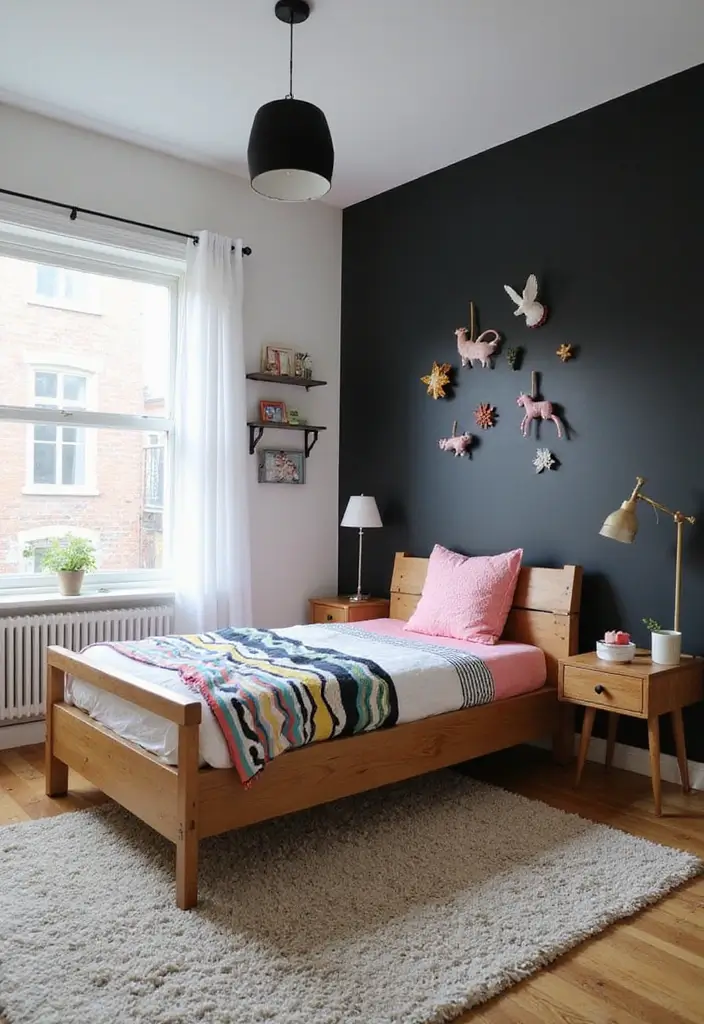
You want a room that feels calm but alive. A classic black and white theme can give you that look. It reads modern and clean, yet it still holds personality. You get a grown up vibe without losing kid-friendly charm. The trick is balance. White walls keep things bright, while a black wall or bold wallpaper adds drama.
Here is why this works.
How to use it in a kid’s room:
– Pick one wall to paint black for a strong focal point.
– Or cover a wall with black and white wallpaper that has a pattern your child loves.
– Keep the other walls white to keep the space airy.
– Use a matte, washable finish so you can wipe marks easily.
Pro Tips:
– Patterned decals on a black wall add texture and interest.
– Colorful furniture makes the room pop against the monochrome backdrop.
– Choose art that shows your child’s personality.
Here is a quick scan of benefits.
With this setup you get a room that feels stylish now and easy to grow into. Swap in new art, textiles, and accessories as tastes change. It stays fresh with small changes, not a full repaint.
This look stays clean and calm as the days go by.
Next steps.
9. Whimsical Watercolors
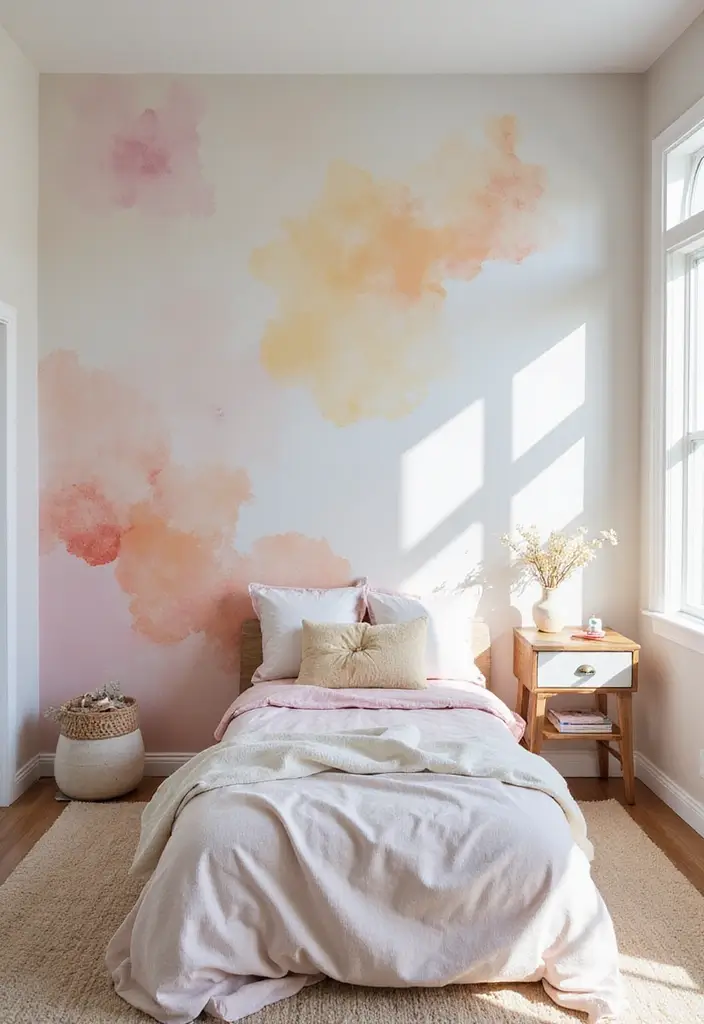
If you want a kid’s room wall that feels like a soft painting, this idea fits. Watercolor walls bring calm and spark to play.
Pick a palette that fits your kid’s room. Pastels create a gentle mood. A few bright tones add a spark of energy. A watercolor sunset or blue-green waves on one wall can become a calm focal point.
What you need
– Clean wall and a white base coat
– Water-based paints in a small color range
– Sea sponge or a soft kitchen sponge
– Flat brush, spray bottle, masking tape
How to do it
– Start with a light wash. Dilute paint with water and dab on softly.
– Build gentle layers for smooth blends.
– Add texture with a sponge. Tap to form soft speckles and swirls.
– Create a feature wall. For a sunset, blend pinks and oranges at the top; for waves, layer blues and greens.
Pro tips
– Keep edges soft. Avoid sharp lines.
– Let layers dry a bit before adding more.
– Pair with light curtains to help the wall shine.
– Use minimal decor so the wall stays the star.
Next steps: test a small patch first, then paint a larger area.
10. Adventure Awaits
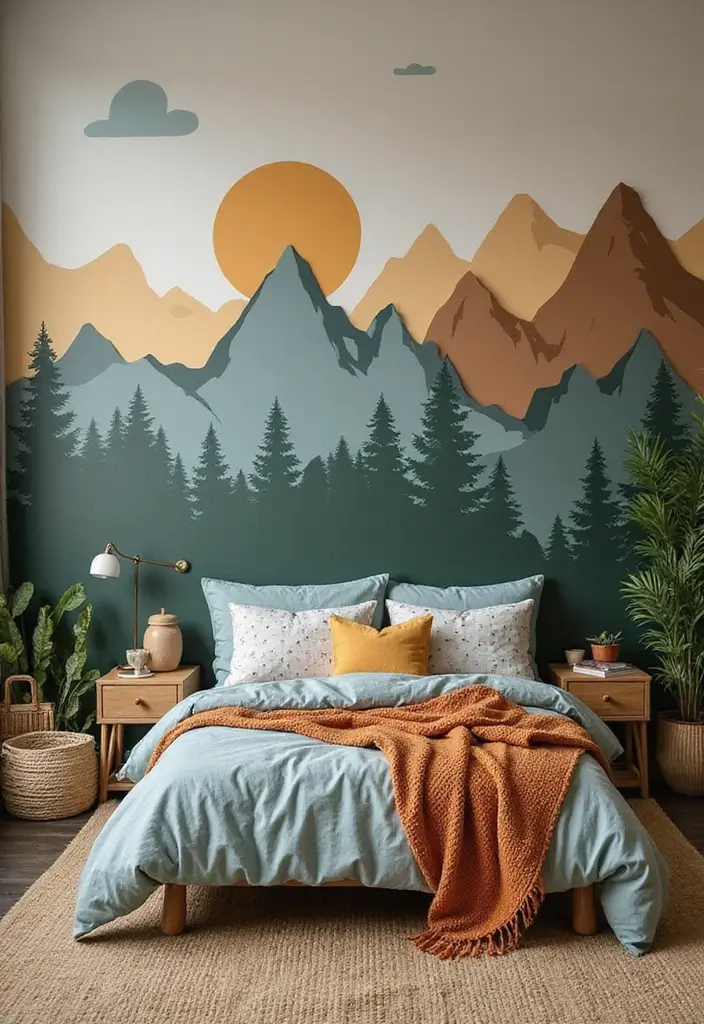
Adventure awaits in a kid’s room painted for play. Here is why this adventure theme fits your space. It uses shades you can live with as they grow. Burnt orange, olive green, and deep brown echo the outdoors and hide smudges. You can sketch simple shapes: mountains, pine trees, and a tent as a cozy corner. This setup stirs imagination while teaching a love for nature and brave exploration.
Make the look feel real with texture. Use wooden desks, shelves, and fabric that mimics the forest. A rug with a simple map or leaf patterns adds depth. Keep the space practical with smart storage so toys and books stay neat.
Pro Tips:
– Use wall decals for quick swaps.
– Choose bedding with maps or animals to reinforce the theme.
– Pick storage that blends with the wood and fabric tones.
With care, this room grows with your child and becomes a place for stories, reading, and small adventures close to home. It is easy to refresh by swapping decals or bedding as hobbies change. Next steps: pick one wall, paint a base color, add decals, and measure for a tent or play corner.
11. Playful Polka Dots
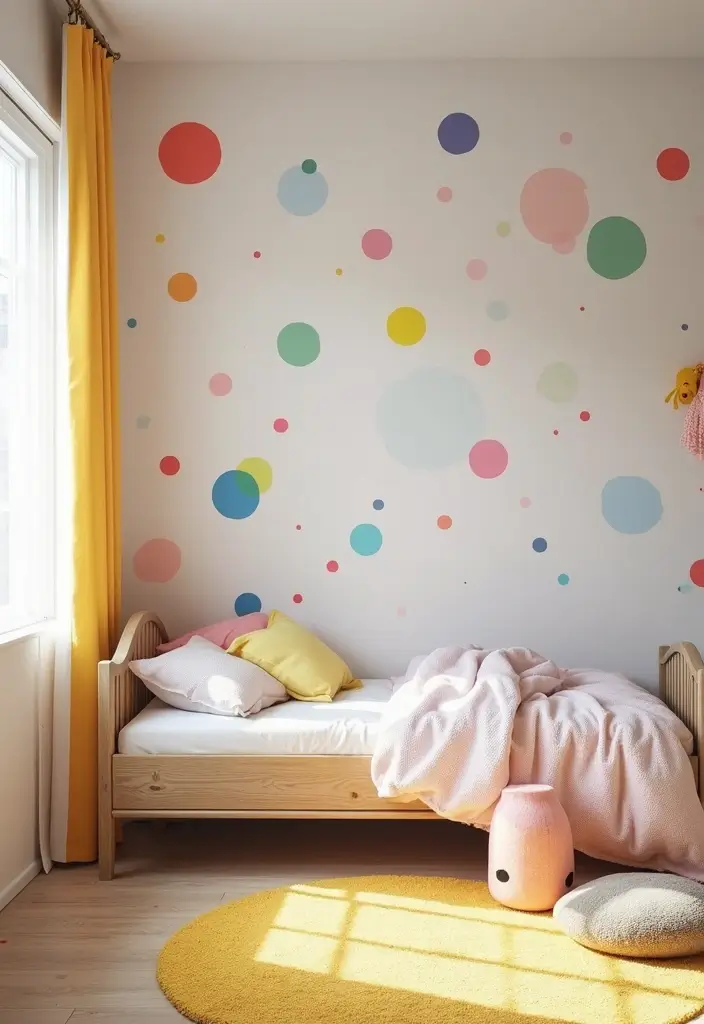
Want a wall that instantly feels alive in a kid’s room? Polka dots do that fast. Start by painting one wall in a solid color, then add dots in different sizes and colors for a playful twist. Try hot pink with sunny yellow, or pair bright shades with soft pastels. Choose non-toxic, water-based paints to keep the room safe. Extend the look by carrying the dot idea into bedding and accessories for a cohesive vibe. Dot sizes can range from tiny to bold, and place the biggest dots where you want the eye to rest.
Pro Tips:
– Use stencils or a round sponge to keep dot sizes steady.
– Mix large and small dots for added interest.
– Add a bold piece of art to balance the busy wall.
Polka dot walls fit many kids bedroom paint ideas. They add energy without crowding the space. This look scales from a small play area to a full-sized kid’s room. Next steps: gather supplies, map a dot plan on paper, then start with a tester wall before painting the real wall.
12. Vintage Vibes
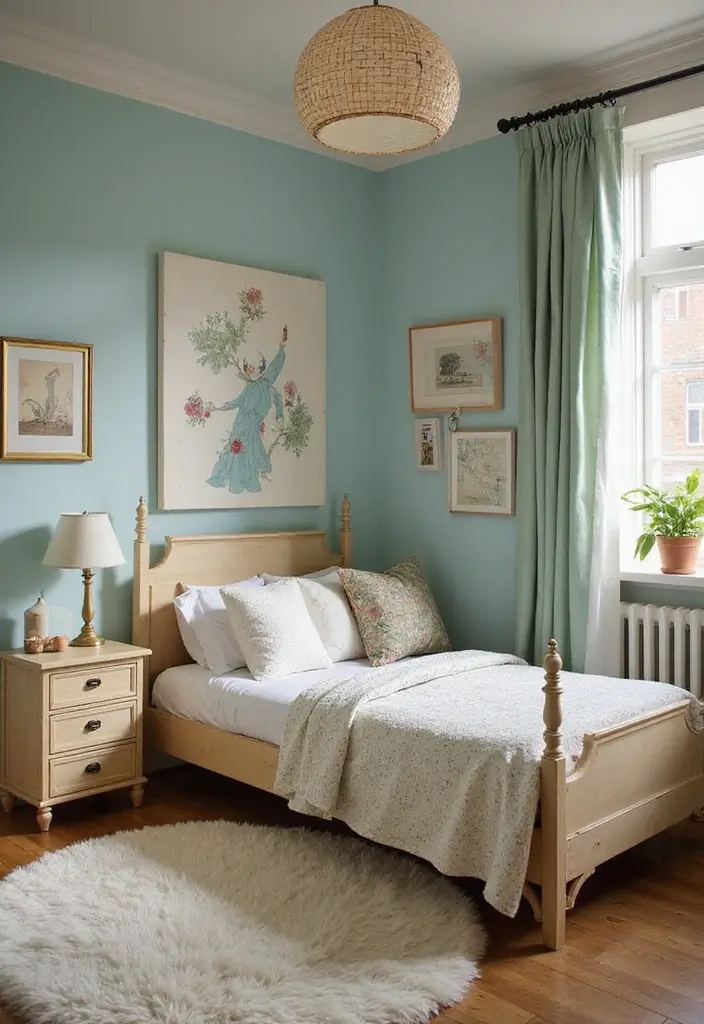
You want a kid’s room that feels warm and easy to love. A vintage vibe can do that. Muted colors pull the space together. Soft peach, faded mint, and light lavender set a calm base. Chalk paint adds texture without shine.
Here is why it works. The mix of soft colors and worn finishes makes walls feel cozy, not loud. It invites your child to explore stories and play long.
Put the theme into action with simple touches. Add botanical prints, tucked-away vintage toys, and a small antique chair or stool. These bits tell a story and age nicely with the room.
Next steps for texture and pattern. Use a light glaze or a thin chalk finish on one wall to create a gentle, lived-in look. Try stencils for tiny florals or delicate vines around a doorway or above a bed. Pair these with matte paint so accents stay soft.
Where it shines. A vintage trio of walls, furniture, and decor creates a calm stage for daily life. It supports reading, imagination, and quiet play.
Pro Tips:
– Add old books or photos on a shelf.
– Use stencils for floral or leaf patterns.
– Create a comfy reading nook with a soft rug and small chair.
A vintage space stays warm and welcoming and invites kids to dream.
13. Creative Chalkboard Walls
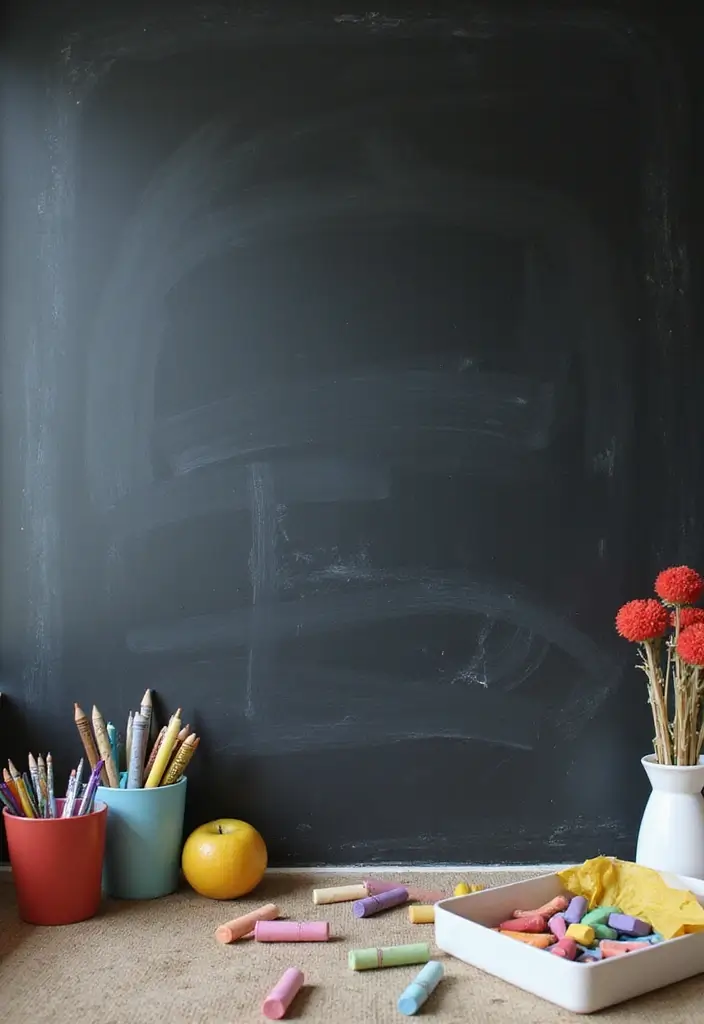
You want a kid-friendly space that invites art, not mess. A chalkboard wall can do that. With chalkboard paint, one wall becomes a canvas for your child. Pick a bold backdrop, like charcoal or forest green, and let them draw. When it dries, wipe clean and start again. It blends play, learning, and creativity in one simple spot.
Here is why it works:
– It invites daily drawing without tearing paper.
– It grows with your child, from doodles to mini lessons.
– It cleans easily with a damp cloth.
What you do to set it up:
– Choose a wall in good light and at kid height.
– Prep the surface: wash it, roughen a little, and dust it off.
– Apply chalkboard paint in two coats. Let each coat dry fully.
– Seal with a wipeable finish for easier cleaning; otherwise keep the classic chalk look.
What you need on hand:
– Chalk pastels in a few colors, a simple eraser, cloth, and a small art cart or bin.
Pro Tips:
– Pair it with a nearby gallery wall to display new art.
– Keep an art cart nearby so supplies stay ready.
Next steps: swap in new color accents or a border now and then. Your child gains a mini art studio that fits the room.
Transform your kids’ bedroom with a chalkboard wall! It’s a canvas for creativity, inviting endless drawings and learning—all while keeping the mess contained. Wipe clean and let the imagination flow!
14. Magical Murals
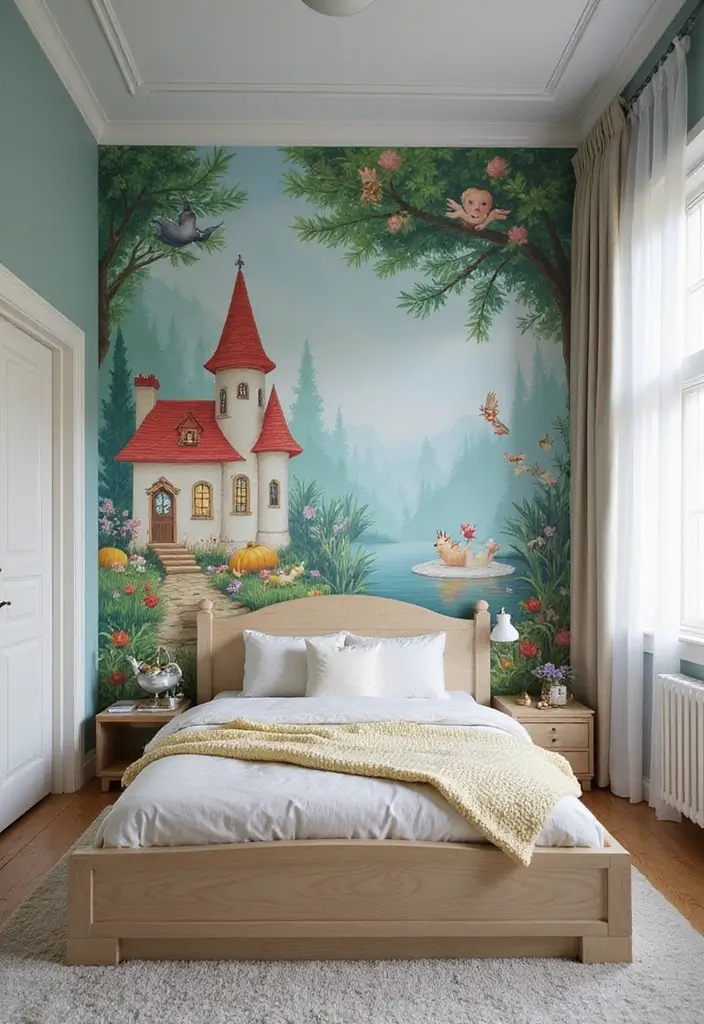
Want a wall that tells a story every day? A magical mural does. Pick a wall in your child’s room and paint a scene from a favorite tale. A castle in the clouds, a calm forest path, or a city street at dusk. Murals give your child a space that feels personal and ready for a new adventure.
Here is how to make it real:
Pro Tips:
– Choose eco-friendly paints. Look for water-based, low VOC, non-toxic options that are easy to clean.
– Plan with a simple sketch. Use a light grid or a projector to map the scene, then trace onto the wall.
– Involve your child. Let them pick the theme and the main colors. Keep the choice small at first if you’re new to painting.
– Start with the big shapes. Focus on the main elements first, then fill in details.
– If the design is complex, hire a professional for the tough parts. Or use stencils and decals to get the look you want.
– Add removable accents. Try chalkboard paint for notes, or removable wall decals so the look can change with interests.
Next steps: keep the surface washable and easy to refresh. Light touch-ups and a clear, safe seal can protect the mural. A magical mural changes a plain room into a small dream space, inviting your child to play and create every day.
Bring your child’s imagination to life with magical murals! A painted scene can turn their room into a canvas of adventure and creativity, making every day a story waiting to be told.
15. Fun and Funky Stripes
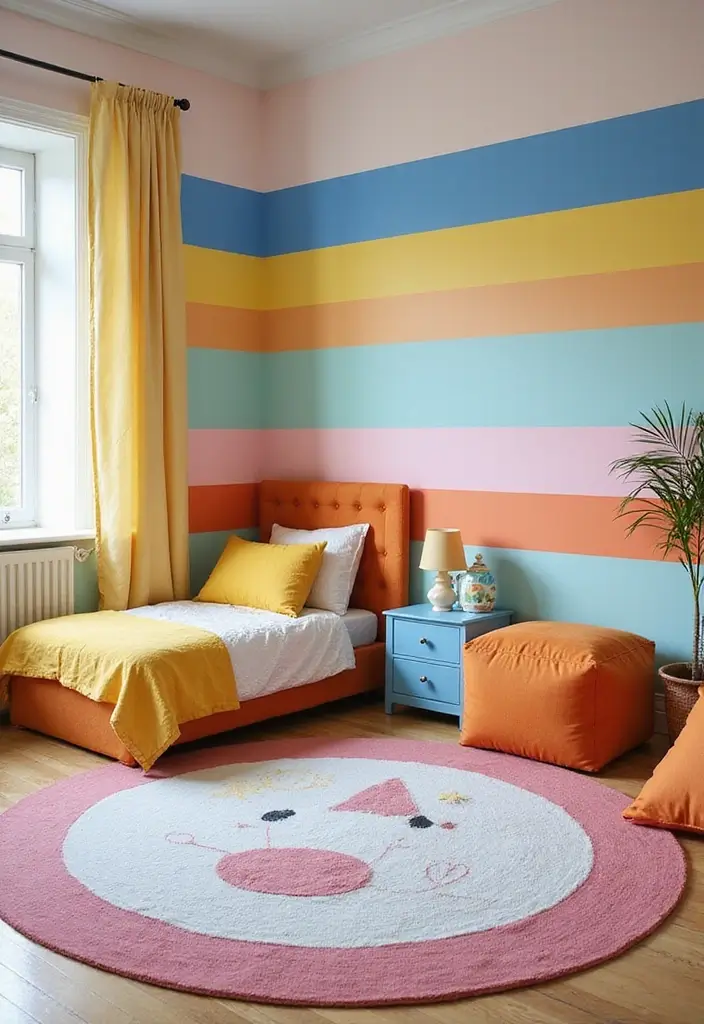
Want walls that wake up a kid’s room? Fun and funky stripes add energy with little fuss. You can run bold bands up the wall or across the room. Vertical stripes can make the ceiling feel higher; horizontal stripes can make a small space look wider. Try bright shades like orange, lime, and sky blue to boost playtime. Match the stripes with solid furniture in colors that echo the stripe palette.
Here is why stripes work: they create rhythm and depth. They can be sized for your room and your child’s age.
What you’ll need:
– Eco-friendly wall paint in 2–4 colors
– Painter’s tape and a clean straightedge
– A level, pencil, ruler
– Drop cloths and clean rags
Steps to stripe walls:
1) Choose 2–3 colors and decide stripe widths. Start with wide bands and add a few thinner lines for balance.
2) Prep the wall. Clean it, fill dents, and let it dry.
3) Apply a light base coat. Let it dry completely.
4) Mark stripes with a level and tape. Use tape to form crisp edges.
5) Paint the stripes. Remove tape while the paint is still a touch wet for clean lines.
6) Wait for drying, add a second coat if needed, then touch up.
Pro Tips:
– Use painter’s tape for sharp lines.
– Vary stripe widths for energy.
– Coordinate bedding and decor with the stripe colors.
Maintenance and care: choose low-VOC, washable paints. Wipe stripes with a damp cloth and enjoy a wall that invites kids to create and explore.
16. Artistic Splatter
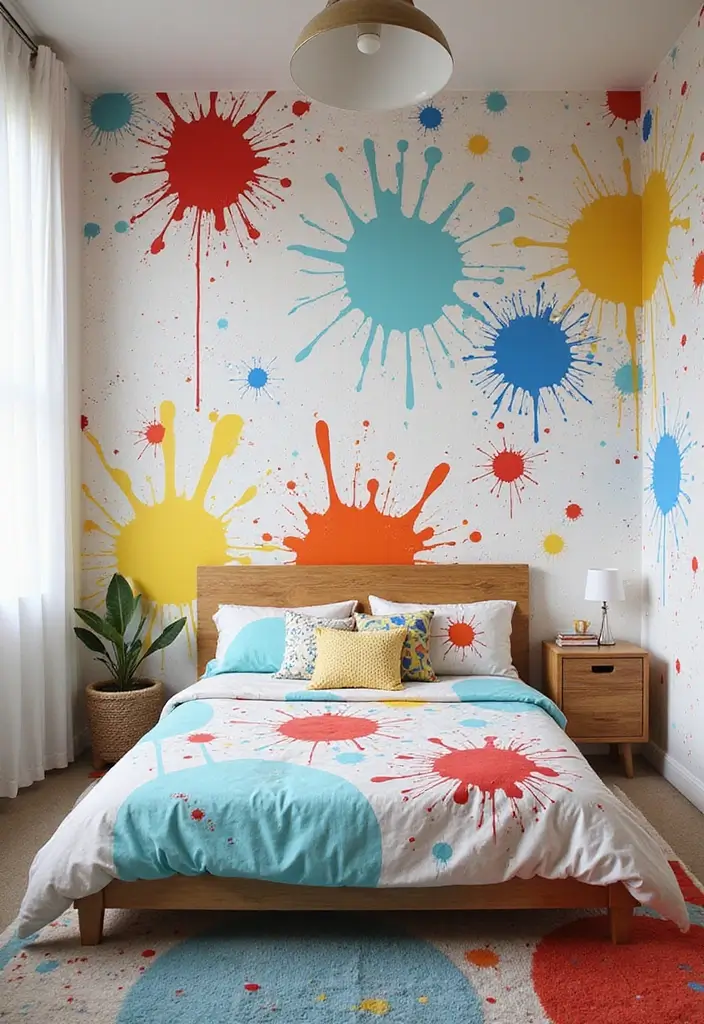
Want a wall that sparks imagination in your kid’s room? Try an artistic splatter design. It’s lively, easy to pull off, and totally kid driven.
Here is why this works: splatter art gives a bold focal point without crowded murals. It lets your child express color choice and personality in a safe, quick project. You get a room that feels fresh, not fussy.
What you need
– Non-toxic acrylic paints in a few bright colors
– A base wall color (ask your child to pick one that contrasts with the splatters)
– Painter’s tape, drop cloths, and old sheets
– Gloves and an apron to keep clothes clean
– A brush, a sturdy sponge, a toothbrush, or a spray bottle
– A small space where you can clean up easily
Step by step
1) Prep the space. Lay down drop cloths and tape off edges you don’t want splattered. Open windows for airflow.
2) Pick colors. Let your child choose a palette. More contrast between base and splatters makes the design pop.
3) Paint the base. Apply the base color and let it dry. This gives a clean canvas for the splatter art.
4) Create the splatters. Dip your tool in paint and flick, spray, or tap to fling color onto the wall. Keep your distance about 12 to 18 inches for control.
5) Layer with care. Add a few splatters of a second or third color. Less is more if you want a crisp look.
Pro tips
– Use gloves and an apron to keep mess low.
– Test your technique on cardboard first.
– Let your kid lead the color choices for a unique result.
Next steps: once the paint dries, remove tape, tidy the area, and add simple furniture touches that echo the wall art. This splatter design will make a kid’s room feel bright and personal, with plenty of room for creativity.
17. Cozy Cabin Retreat
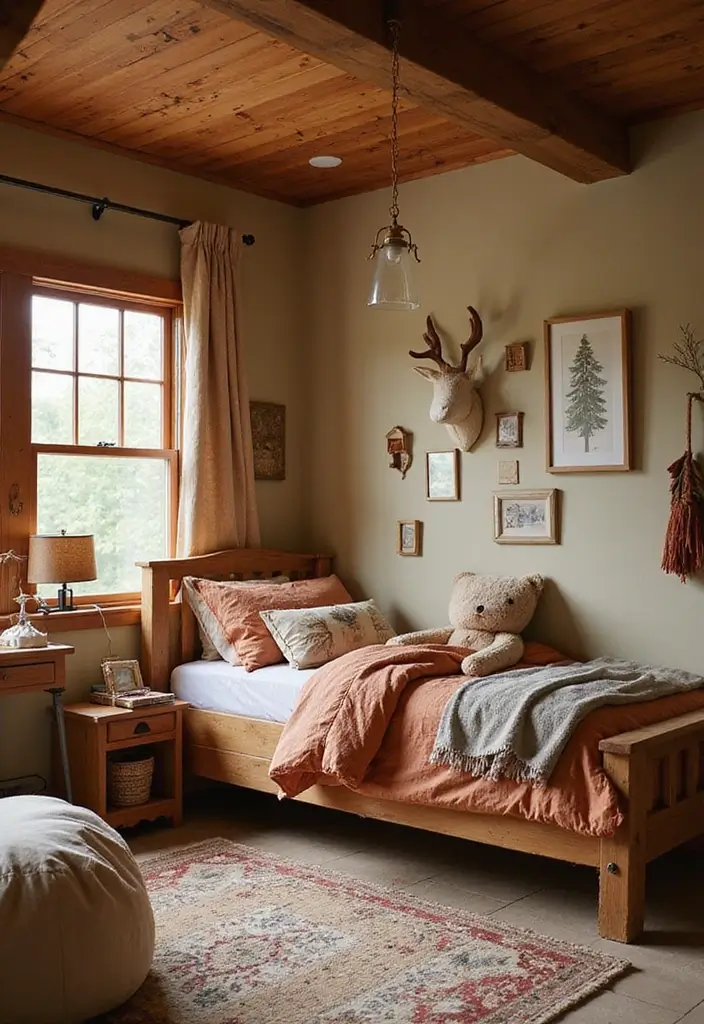
Ready to turn your child’s room into a warm mountain cabin? Here is why a cozy cabin retreat works for kids and how to do it.
Start with color. Use warm, earthy tones—deep browns, rich greens, and warm creams. These hues feel calm and grounding, perfect for a kid who needs a restful space.
Next, wall texture. Paint walls to mimic wood paneling. Try a faux wood panel effect or wide board lines painted in a soft shade. It sets the mood without heavy decor.
Add an accent wall. A mountain landscape or forest scene can become the room’s hero, sparking stories and adventures as your child naps or reads.
This setup creates a snug, inviting space. It welcomes quiet time and makes room for imagination.
Pro Tips:
– Add wooden furniture to enhance the cabin feel.
– Use soft textiles like flannel or faux fur for bedding.
– Include nature-inspired decor pieces to tie the look together.
A cozy cabin retreat invites a love of the outdoors. It also gives your child a safe, comfy sanctuary for play and rest.
Start small today.
18. Bright and Bold Floral
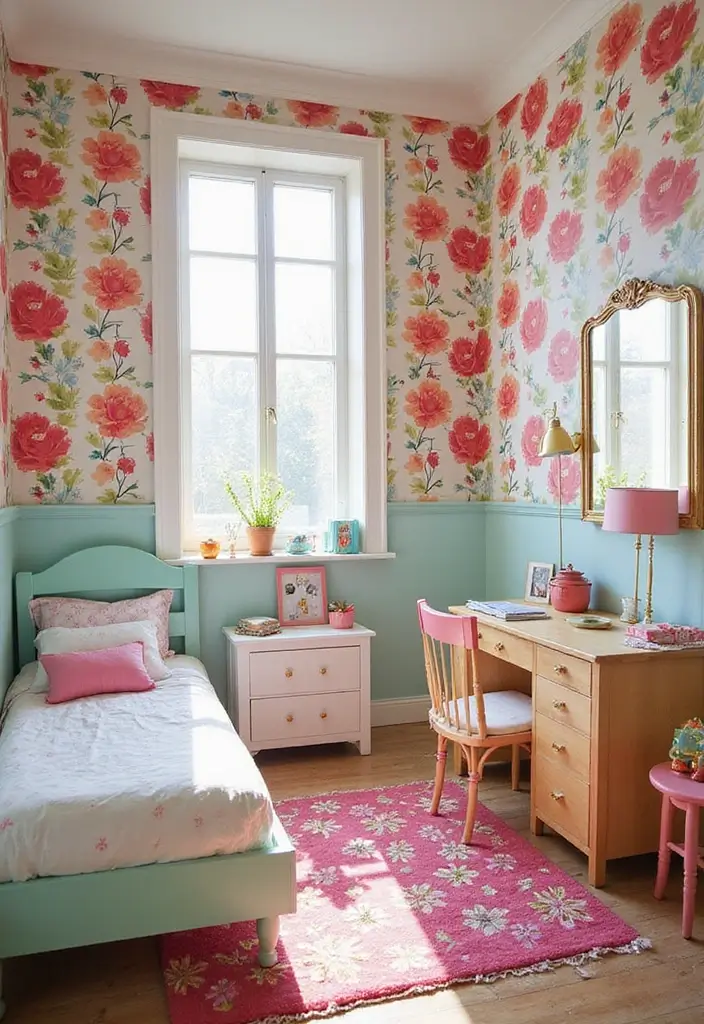
You want a kids bedroom that feels alive but not loud.
Floral walls can help by bringing nature inside with color.
Start with a simple palette of two or three hues.
For a playful look, paint large floral patterns on the walls.
Keep the rest of the room steady with solid furniture.
Choose a non-toxic paint so you protect your child.
Big blooms draw the eye and spark imagination.
Consider an accent wall with oversized flowers for drama.
Let flowers appear on bedding and curtains to tie the room together.
Test color swatches on an actual wall patch first.
And check how the finish holds up after a spill test.
Choose a color range that fits your lighting and room size.
Soft pinks, greens, and yellows work well with florals.
Use low VOC or water-based paint to stay safe.
A matte or satin finish helps with cleaning.
Plan the process in stages to save time.
Mask floors and use drop cloths to keep mess down.
Pro Tips:
– Use stencils for clean, repeatable petals
– Test a small patch first to see color and washability
– Create an accent wall with oversized flowers for maximum impact
– Match the floral motifs in bedding and curtains for harmony
You can swap patterns as your child grows.
Paint in sections if you prefer easier changes later.
Remember safety and maintenance so the space stays inviting.
19. Cool Color Blocking
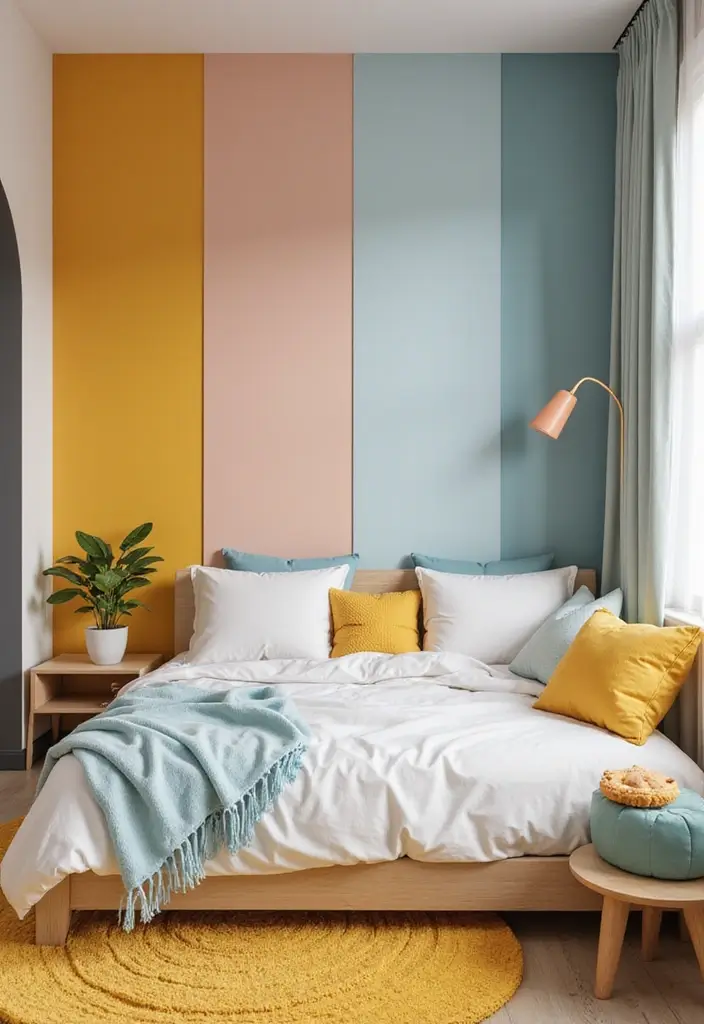
Looking for a wall that pops without overpowering the room. Color blocking gives you that clean, modern look you want.
What it is: you paint bold wall areas in different shapes and sizes. The result is depth and a playful vibe. Use non-toxic, low-VOC paints for safety.
Placement matters. Plan around doors, windows, and light to keep the wall feeling balanced.
How to do it:
– Pick 2 to 4 colors that go with the bed, rug, and shelves.
– Sketch a simple plan. Decide where blocks will sit and what shapes you want. Start with a large block as a base, then add smaller blocks.
– Tape carefully. Use painter’s tape to create clean edges.
– Paint in thin, even coats. Let each coat dry before adding the next.
– Remove tape at the right time to reveal sharp lines.
– Add a few small accents later, like a painted border or tiny dots, if you want.
Pro Tips:
– Use painter’s tape for crisp edges.
– Choose colors that complement the room’s furnishings.
– Don’t be afraid to experiment with different shapes.
Next steps: step back and view the wall in different lights. If it feels busy, scale back the blocks or switch a color. Cool color blocking energizes the space for play and creativity.
20. Charming Country Cottage
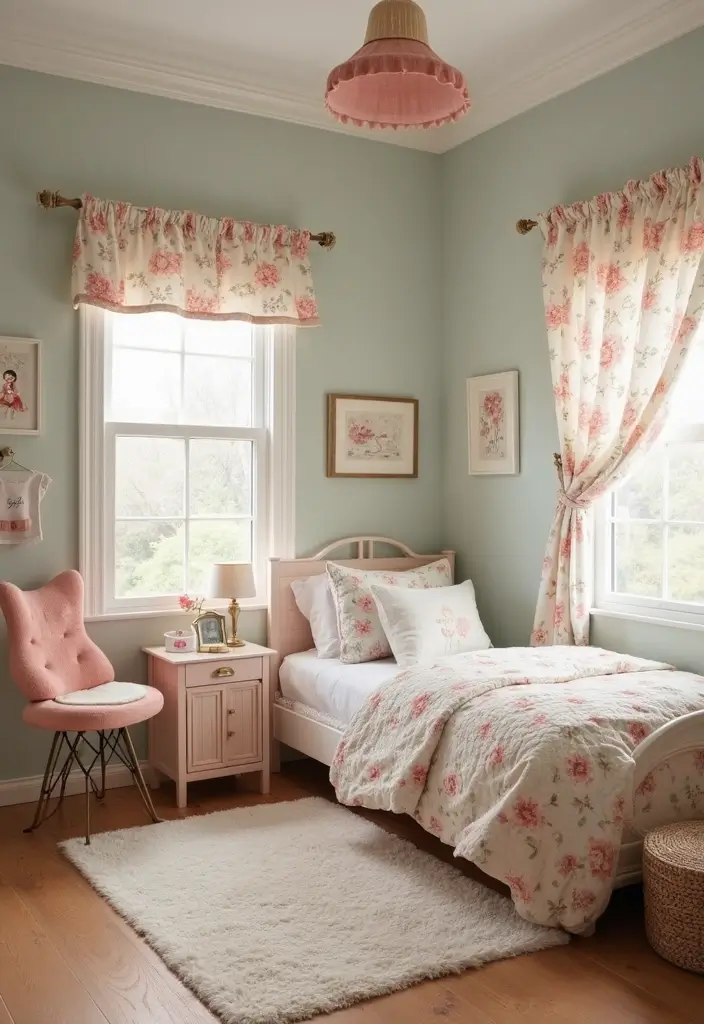
Capture the essence of a cozy countryside with a charming cottage theme!
Use soft, muted colors like pale blue, soft pink, and buttery yellow for a warm, inviting atmosphere. You can also paint delicate patterns like tiny flowers or vines along the edges of the walls to enhance the cottage feel. This design creates a soothing environment perfect for relaxation and sleep.
Emphasizing eco-friendly paints ensures a healthy space for your child.
Pro Tips:
– Incorporate vintage decor pieces like floral prints and rustic furniture.
– Consider using textiles with floral patterns for bedding and curtains.
– Add soft lighting to enhance the cozy feel.
A charming country cottage theme creates a serene escape, inspiring creative play and calm moments.
A cozy cottage-inspired space can transform your child’s bedroom into a serene retreat. Choose soft, eco-friendly paints to create a healthy, inviting atmosphere that nurtures relaxation and dreams.
21. Exciting Electric Hues
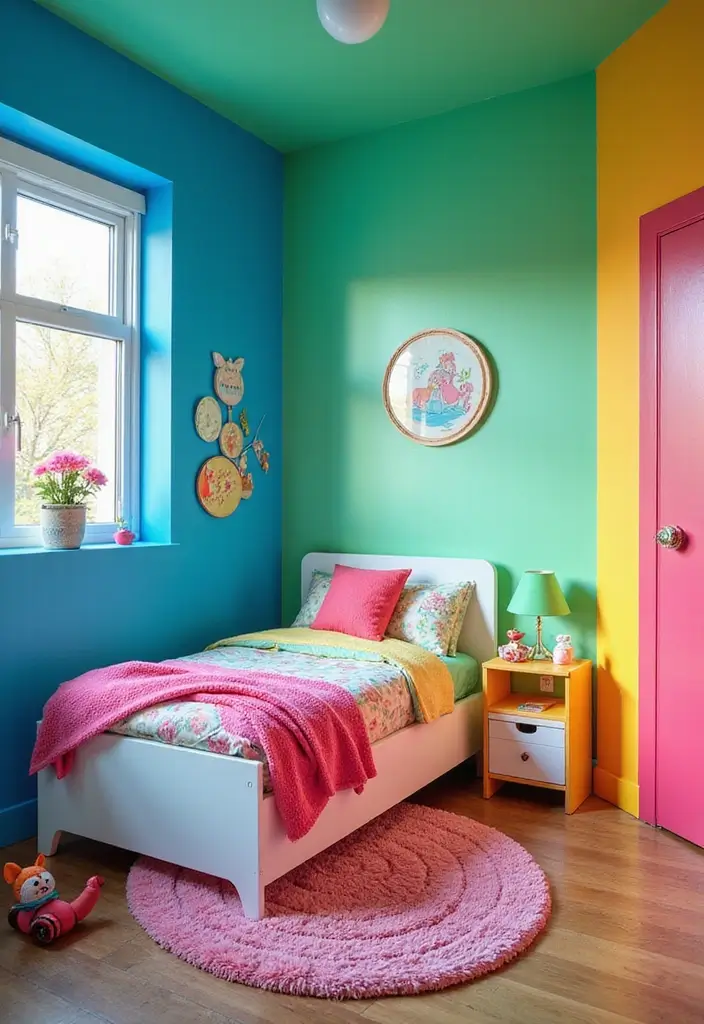
Are you after a wall that wakes up a kid’s imagination without turning the room chaotic? An electric hues theme can do that. Start with two or three bright colors: electric blue, neon green, and hot pink, and let them play off each other. You can paint wall shapes, or run a bold color block across one wall. A soft ombre with a bright top shade can also work, as long as the edges stay clean. This idea pairs well with other kids bedroom paint ideas.
Here is why this approach helps growth. Color sparks curiosity and makes learning feel playful. Pick paints that are non-toxic and low-VOC. You get safety for rooms where kids touch walls, draw on them, and roll around on the floor.
Pro Tips:
– Pair bright hues with neutral furniture so the room breathes.
– Use colorful accessories—throws, rugs, curtains—to bring the look together.
– Try glow-in-the-dark stars or stripes for a night-time surprise.
Next steps: test swatches on small poster boards before committing to a wall. Use painter’s tape and sturdy stencils for clean edges. Finish with a washable topcoat so spills don’t spoil the vibe. An electric hues space invites your child to explore and grow.
22. Soft Textured Finishes
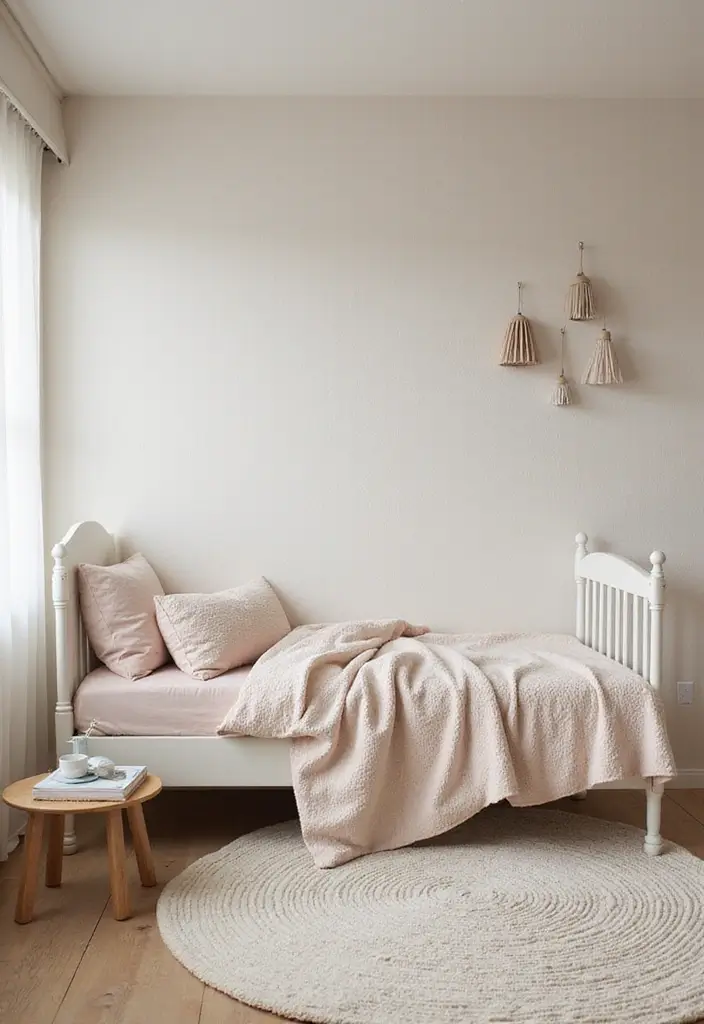
You want a kid’s room that feels cozy and calm. Soft textured finishes can help. With sponging or rag rolling, you create a wall that looks gentle and cloud-like. Pair this with colors like lavender or pale blue to invite rest and focus. Textured walls add depth and warmth, making the room feel alive for play and quiet time.
Here is why texture works: it catches light differently than flat walls and adds interest without loud prints. It also gives a warm base for toys, beds, and lamps.
Choose paints that are eco-friendly and low in fumes. That keeps the space safe for sleeping and learning.
Pro Tips:
– Practice on a scrap board or a hidden patch first to see the effect.
– Use a sponge for soft circles or rag rolling for cloudy streaks.
– Keep the rest of the room simple so texture can shine.
– Add soft textiles, cushions, and curtains in the same color family.
Next steps: textured walls are easy to refresh. They work with many styles and grow with your child.
23. Fantasy Land
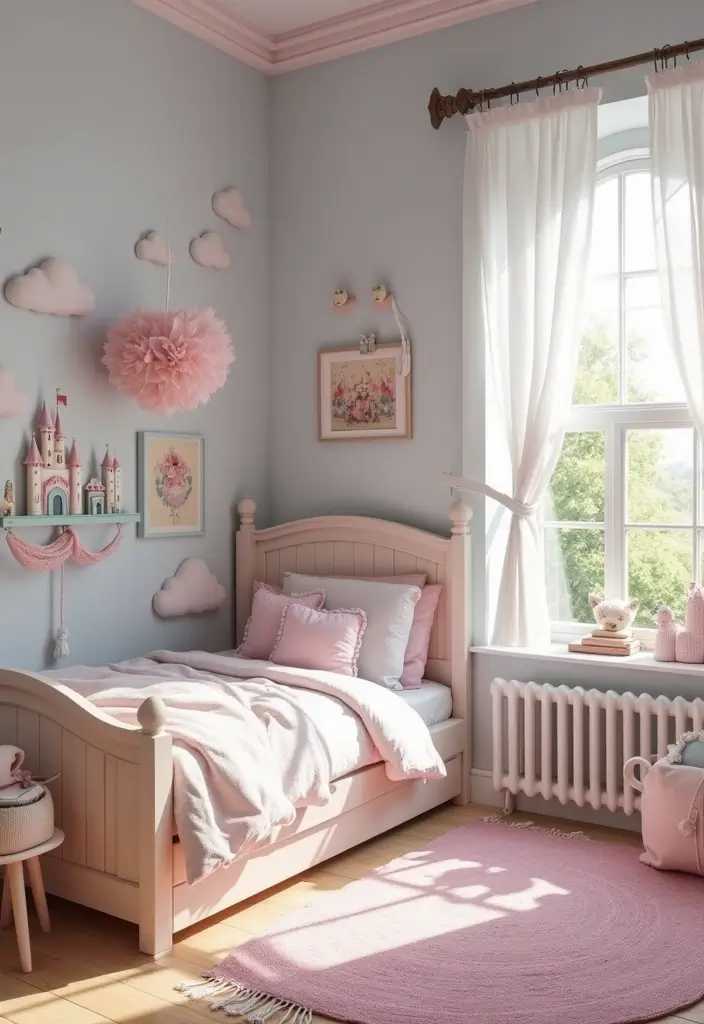
You’re looking to turn a dull wall into a canvas for your child’s daydreams. A fantasy land on the walls can spark endless stories and brave play.
Choose a soothing palette: pale pink, soft purple, and mint green work well together. They calm the mind while leaving room for bold accents. Paint most walls in a light shade, then add accents with cloud shapes, castle silhouettes, or friendly creatures. You can freehand or use decals for quick, clean looks. Decals let you swap scenes as your child grows.
Focus on eco-friendly paints so you keep the air safe. Look for low VOCs and water-based formulas. They feel smooth, dry fast, and wash easy.
Pro Tips:
– Use decals for easy changes without re-painting.
– Add fantasy bedding and cozy curtains that echo the colors.
– Create a small reading nook with fairy-tale books and soft lighting.
This setup invites kids to tell stories, plan adventures, and relax after a busy day. The space should feel safe and inviting, not crowded. Keep furniture simple and low so kids can move easily. With the right touches, a fantasy land becomes a daily escape that grows with your child and imagination soars.
24. Timeless Monochrome
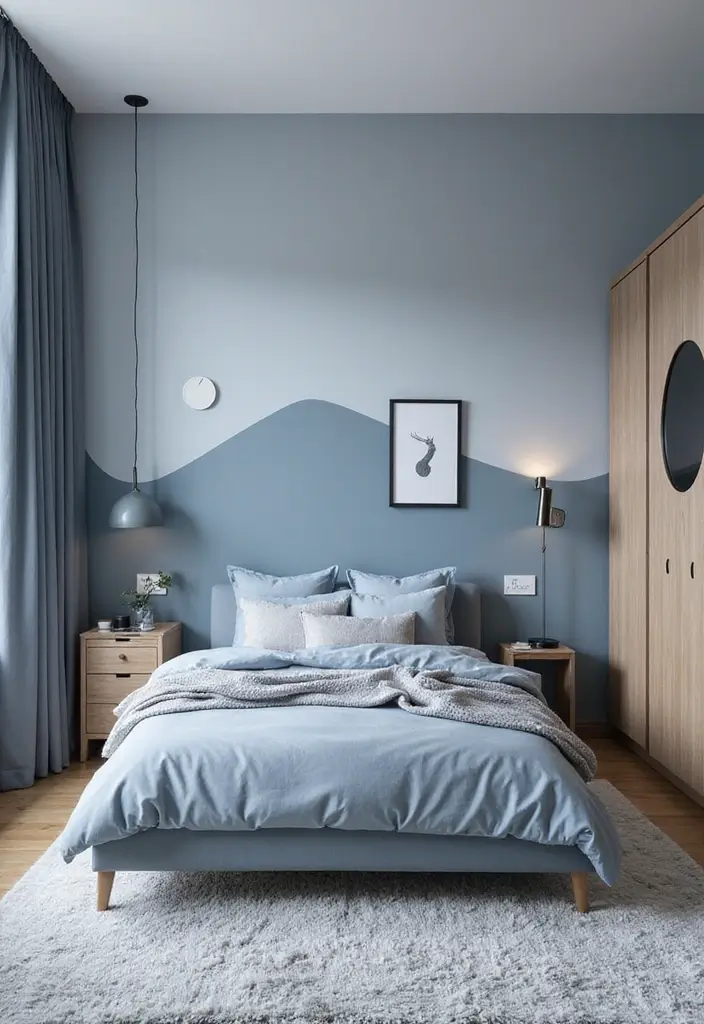
You want a kid’s room that feels calm now and grows with them. A timeless monochrome palette can give you that. Start with a single base color and add shades to build depth. Try blues or grays in light, mid, and dark tints. White trims keep the space bright and clean. Patterned textiles and simple decor keep the room lively. Use non-toxic paints to protect your child.
Pro Tips:
– Add pops of contrasting color with small accents like pillows, a rug, or a lamp.
– Mix textures through fabrics, rugs, wall art, and a soft throw.
– Let the look grow with your child by choosing flexible furniture and neutral large pieces.
Here is why monochrome works: it blends with trends, age, and changes in taste. Next steps: test color swatches on a wall, compare two shades side by side, and plan textiles first for a quick update. If the room seems chilly, warm it with wood tones and soft lighting. Practical tip: choose a matte finish on walls to reduce glare and hide fingerprints. This simple approach keeps the room easy to tidy, too. With a single base and friendly textures, you get a chic, kid friendly space. That grows better over time.
25. Magical Galaxy
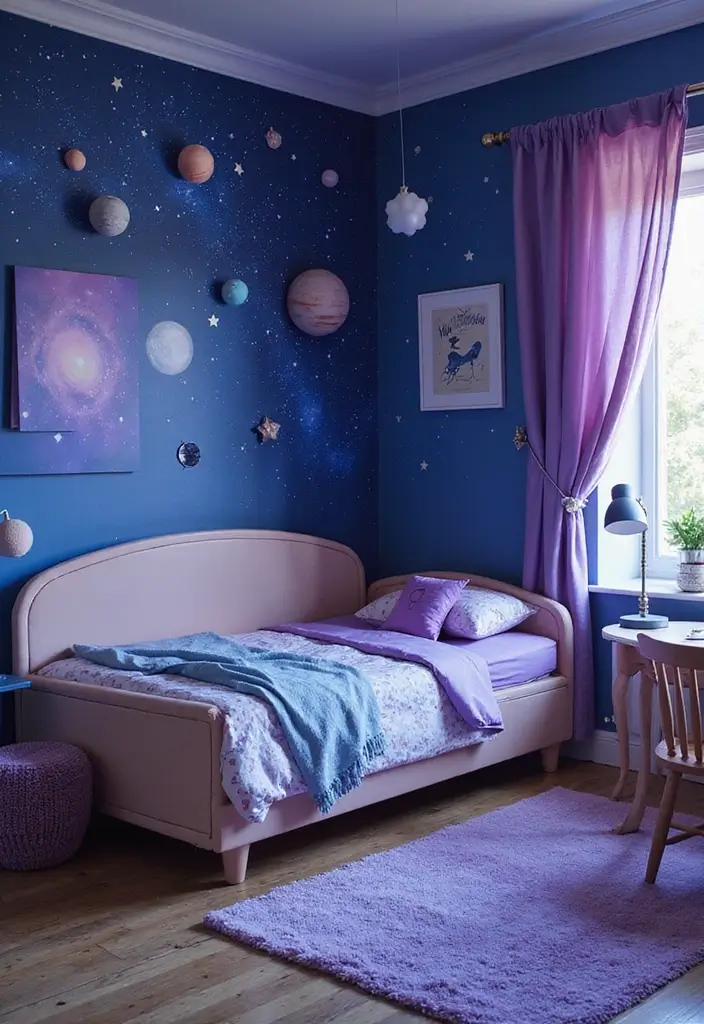
Want a kid’s room that feels open, dreamy, and full of discovery? A galaxy theme can deliver. Here is why it works: it blends deep, calm skies with bright stars, inviting both play and quiet study.
Next, plan your wall color and layout. Start with a deep navy or midnight blue as the base. Add gentle swirls of purple and soft pink to hint at a living night sky. Leave a section lighter to keep the room from feeling heavy.
Next, bring the space to life with stars, planets, and comets. Use stencils or decals for clean shapes, then add white and silver dots for a starry look. A few larger planets will pop against the dark background.
Install glow-in-the-dark accents or star decals on the ceiling so the room shines after lights out. Soft lighting matters, too. Try fairy lights, dimmable LED strands, or a small nebula lamp to create a calm glow.
Decor and bedding complete the vibe. Choose star-shaped pillows, galaxy-pattern sheets, and a cozy throw. A small shelf with kid-friendly astronomy books keeps curiosity close at hand.
Pro Tips:
– Use eco-friendly paints for a safer room.
– Stencils or decals help you get precise galaxy shapes.
– Add soft lighting to heighten the space feel.
– Keep a few space books nearby to fuel questions and learning.
A galaxy theme grows with your child. Swap bedding, decals, or decor as their space interests change. It stays engaging without a big redo, and it makes bedtime feel like a tiny adventure.
Next steps: pick a palette, gather supplies, and start with a simple star border or a few glow stars. Then build out with planets and soft lighting as you go.
Conclusion
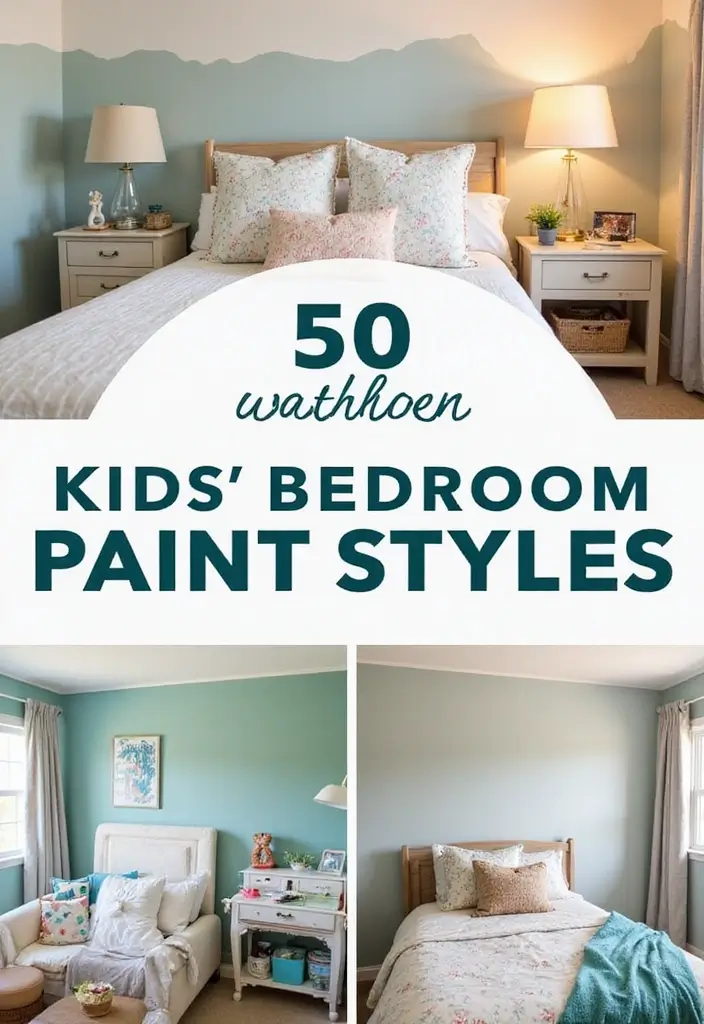
Creating a vibrant and imaginative bedroom for your child can be a fun and rewarding experience.
From playful polka dots to calming nature palettes, these eco-friendly paint ideas inspire creativity and promote a healthy environment.
No matter which theme you choose, the most important thing is to let your child’s personality shine through their space. Happy painting!
Frequently Asked Questions
What are some eco-friendly kids bedroom paint ideas?
If you’re looking for eco-friendly options, consider using paints that are low in volatile organic compounds (VOCs) and made from natural materials. You can explore themes like Nature’s Palette with soft greens and earthy browns, or Whimsical Watercolors, which create a gentle mood without harmful chemicals. These choices not only enhance the room’s aesthetics but also promote a healthier environment for your child.
How can I create a vibrant kids room with colorful wall designs?
To create a vibrant kids room, think about using bold geometric shapes or playful polka dots. These designs can be easily achieved with painter’s tape and a few bright colors like teal, orange, and yellow. You can also try color blocking for a clean and modern look. The key is to pick colors that resonate with your child’s personality and interests!
What themed bedroom colors work best for kids?
Themed bedroom colors can vary widely based on your child’s interests. For a space adventure theme, deep navy blue or midnight black can mimic the night sky, while a forest theme might use earthy greens and browns. It’s important to choose colors that inspire imagination and creativity while also being calming and inviting.
Are playful paint techniques easy to implement at home?
Absolutely! Playful paint techniques like artistic splatter and fun and funky stripes are not only fun but also simple to implement. Just gather some paint, brushes, and painter’s tape, and you can create unique designs with minimal fuss. These techniques allow you to easily transform a plain wall into a canvas that sparks creativity and joy in your child’s room.
What are some creative paint patterns that can grow with my child?
Creative paint patterns like timeless monochrome or classic black and white can easily grow with your child. These designs provide a versatile backdrop that can adapt as their tastes change. You can also use a base color and incorporate various shades to add depth, ensuring the room stays stylish and age-appropriate throughout the years.
Related Topics
kids bedroom paint ideas
eco-friendly decor
colorful wall designs
playful paint techniques
themed bedroom colors
creative paint patterns
vibrant kids room
easy DIY
nature-inspired colors
whimsical designs
color blocking
magical murals

